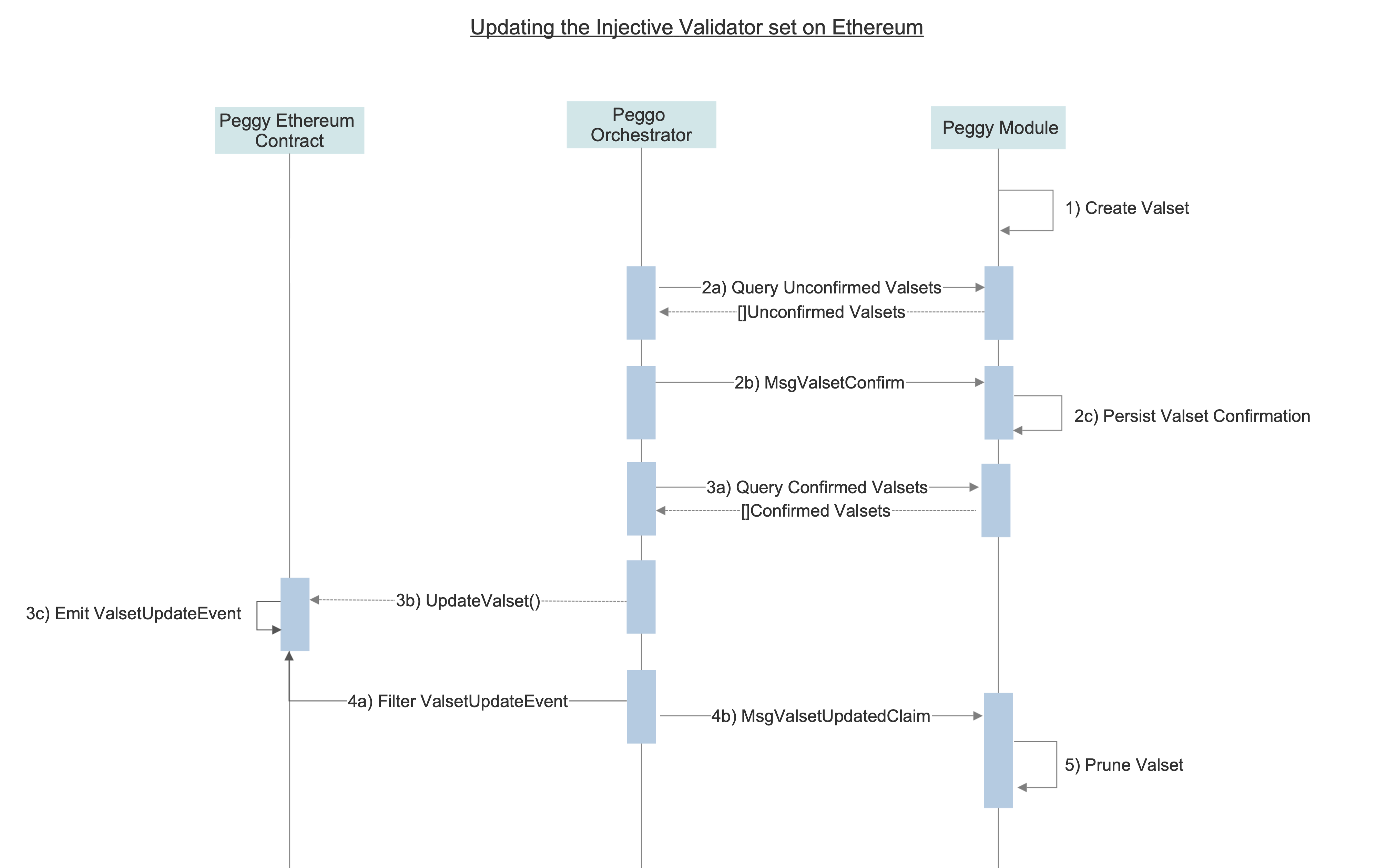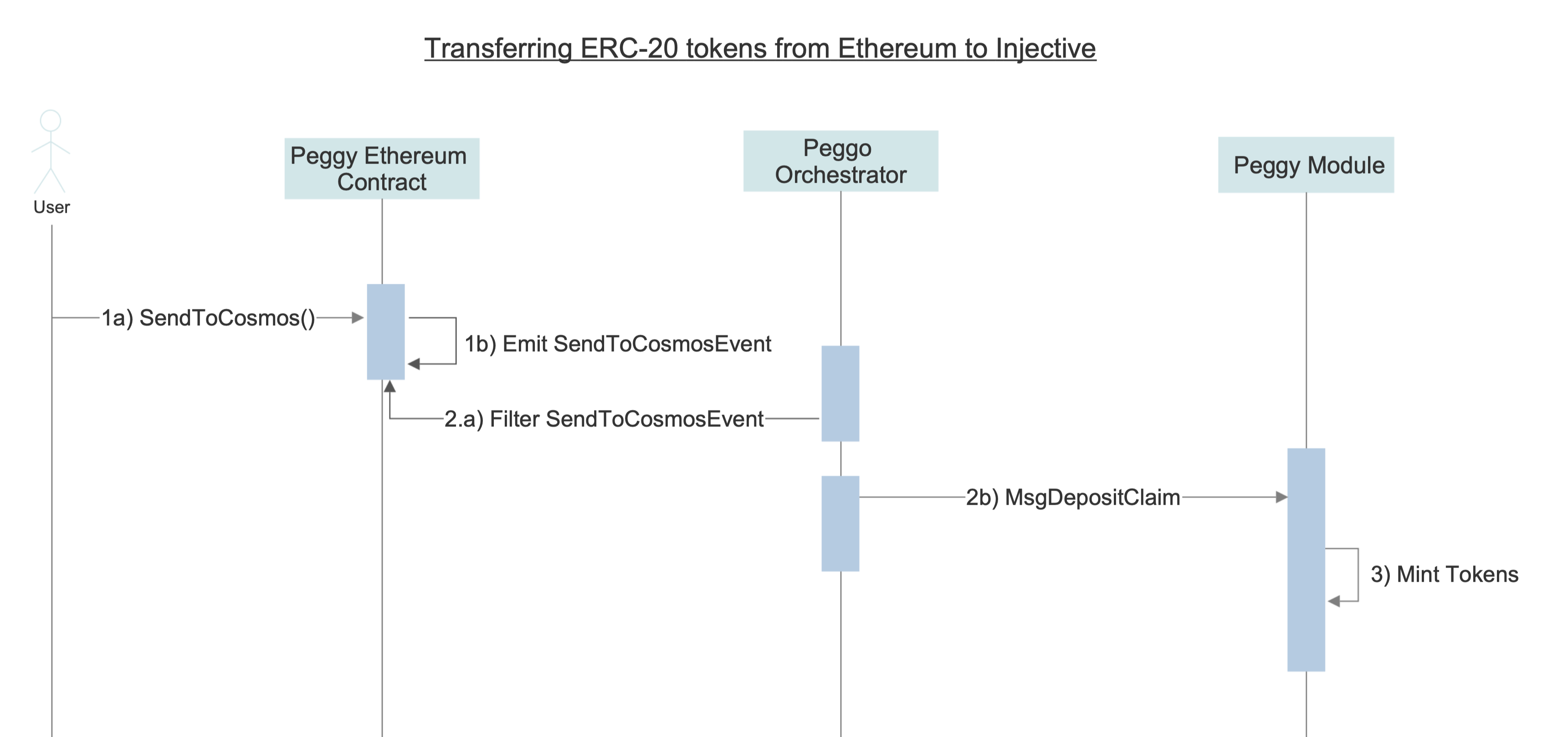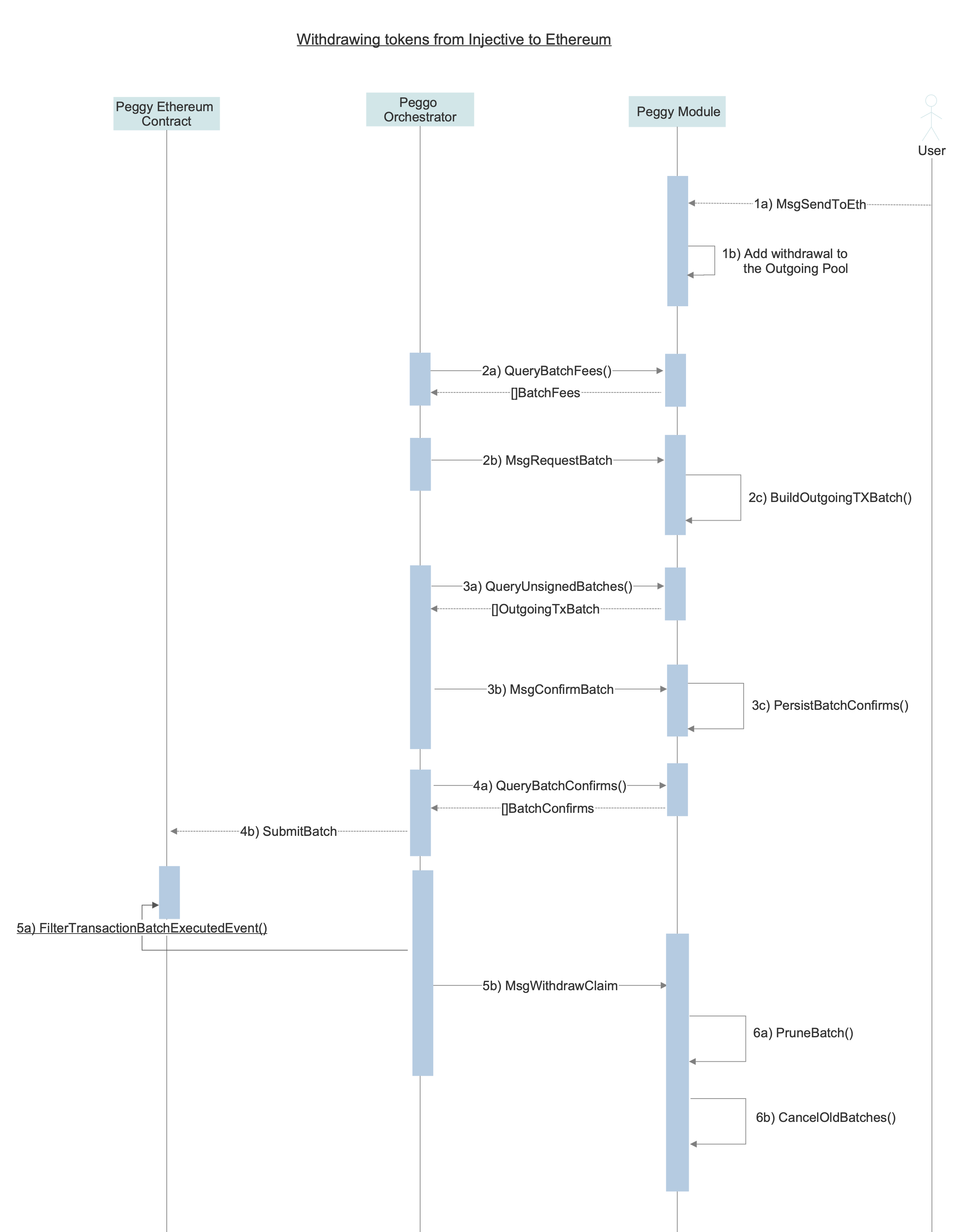Workflow
Conceptual Overview
To recap, each operator is responsible for maintaining 3 secure processes:
- An Injective Chain Validator node (
injectived) to sign blocks - A fully synced Ethereum full node
- The
peggoorchestrator which runs:- An
Eth Signer, which signs newValidator Setupdates andTransaction Batches with theOperator's Ethereum keys and submits using messages. - An
Oracle, which observes events from Ethereum full nodes and relays them using messages. - A
Relayerwhich submits confirmedValidator Setupdates andTransaction Batches to thePeggy Contracton Ethereum - A
Batch Requesterwhich observes (new) unbatched transactions on Injective and decides which of these to batch according to the cofiguredminBatchFeeUSDvalue
- An
Combined, these 3 entities accomplish 3 things:
- Move assets from Ethereum to Injective
- Move assets from Injective to Ethereum
- Keep the
Peggy.solcontract in sync with the activeValidator Seton Injective
Batch Requester
The purpose of the Batch Requester is only in creating transaction batches (aggregated by specific token) on the Injective side.
When a user wants to withdraw assets from Injective to Ethereum, they send a special transaction to Injective (MsgSendToEth) which is added to Peggy Tx pool. Batch Requester continually queries for unbatched transactions by asset type (token), determining whether it's worth to batch them. If for a specific asset a batch would satisfy minBatchFeeUSD, it informs peggy to bundle these transactions into a batch (MsgRequestBatch), so they could eventually be picked up by a Relayer.
Eth Signer
All contract calls on Peggy.sol accept an array of signatures provided by a validator set stored in the contract.
Validators make these signatures with their Delegate Ethereum address: this is an Ethereum address set by the validator using the SetOrchestratorAddress message. The validator signs over this Ethereum address, as well as an Injective Chain address and submits it to the Injective chain to register these addresses for use in the signing flow (explained below) and Oracle subsystem.
The Delegate Ethereum address then represents that validator on the Ethereum blockchain and will be added as a signing member of the multisig with a weighted voting power as close as possible to the Injective Chain voting power.
The Eth Signer plays a crucial role in moving assets from Injective to Ethereum as well as keeping the Validator Set on Peggy.sol updated.
Whenever there is an unconfirmed Validator Set update or unconfirmed Transaction Batch on Injective, this process fetches it from the peggy module, signs it with the provided Ethereum address and sends a MsgValsetConfirm/MsgBatchConfirm back to peggy. Failure to do in a certain amount of time will result in validator slashing. In other words, this process must be running at all times.
Oracle
All Operators run an Oracle binary. This separate process monitors an Ethereum node for new events involving the Peggy Contract on the Ethereum chain. Every event that Oracle monitors has an event nonce. This nonce is a unique coordinating value for a Claim. Since every event that may need to be observed by the Oracle has a unique event nonce Claims can always refer to a unique event by specifying the event nonce.
- An
Oracleobserves an event on the Ethereum chain, it packages this event into aClaimand submits it to the Injective Chain as an Oracle message - Within the
peggymodule thisClaimeither creates or is added to an existingAttestationthat matches the details of theClaim. Once more than 66% of the activeValidatorset has made aClaimthat matches the givenAttestationtheAttestationis executed. This may mint tokens, burn tokens, or whatever is appropriate for this particular event. - In the event that the 2/3 of the validators can not agree on a single
Attestation, the oracle is halted. This means no new events will be relayed from Ethereum until some of the validators change their votes. There is no slashing condition for this, with reasoning outlined in the slashing spec
Relayer
Relayers cover all messages that need to be submitted to Ethereum from Injective. This includes Validator Set updates and Transaction Batches that the validators have confirmed on. Keep in mind that these messages cost a variable amount of money based on wildly changing Ethereum gas prices, so it's not unreasonable for a single batch to cost over a million gas.
A major design decision for our relayer rewards was to always issue them on the Ethereum chain. This has downsides, namely some strange behavior in the case of validator set update rewards.
But the upsides are undeniable, because the Ethereum messages pay msg.sender any existing bot in the Ethereum ecosystem will pick them up and try to submit them. This makes the relaying market much more competitive and less prone to cabal like behavior.
Types of Assets
Native Ethereum assets
Any asset originating from Ethereum which implements the ERC-20 standard can be transferred from Ethereum to Injective by calling the sendToInjective function on the Peggy.sol contract which transfers tokens from the sender's balance to the Peggy contract.
The validators all run their oracle processes which submit MsgDepositClaim messages describing the deposit they have observed. Once more than 66% of all voting power has submitted a claim for this specific deposit representative tokens are minted and issued to the Injective Chain address that the sender requested.
These representative tokens have a denomination prefix of peggy concatenated with the ERC-20 token hex address, e.g. peggy0xdac17f958d2ee523a2206206994597c13d831ec7.
Native Cosmos SDK assets
An asset native to a Cosmos SDK chain (e.g. ATOM) first must be represented on Ethereum before it's possible to bridge it. To do so, the Peggy contract allows anyone to create a new ERC-20 token representing a Cosmos asset by calling the deployERC20 function.
This endpoint is not permissioned, so it is up to the validators and the users of the Peggy module to declare any given ERC-20 token as the representation of a given asset.
When a user on Ethereum calls deployERC20 they pass arguments describing the desired asset. Peggy.sol uses an ERC-20 factory to deploy the actual ERC-20 contract and assigns ownership of the entire balance of the new token to the Peggy contract itself before emitting an ERC20DeployedEvent.
The peggo orchestrators observe this event and decide if a Cosmos asset has been accurately represented (correct decimals, correct name, no pre-existing representation). If this is the case, the ERC-20 contract address is adopted and stored as the definitive representation of that Cosmos asset on Ethereum.
End-to-end Lifecycle
This document describes the end to end lifecycle of the Peggy bridge.
Peggy Smart Contract Deployment
In order to deploy the Peggy contract, the validator set of the native chain (Injective Chain) must be known. Upon deploying the Peggy contract suite (Peggy Implementation, Proxy contract, and ProxyAdmin contracts), the Peggy contract (the Proxy contract) must be initialized with the validator set.
The proxy contract is used to upgrade Peggy Implementation contract which is needed for bug fixing and potential improvements during initial phase. It is a simple wrapper or "proxy" which users interact with directly and is in charge of forwarding transactions to the Peggy implementation contract, which contains the logic. The key concept to understand is that the implementation contract can be replaced but the proxy (the access point) is never changed.
The ProxyAdmin is a central admin for the Peggy proxy, which simplifies management. It controls upgradability and ownership transfers. The ProxyAdmin contract itself has a built-in expiration time which, once expired, prevents the Peggy implementation contract from being upgraded in the future.
Then the following peggy genesis params should be updated:
bridge_ethereum_addresswith Peggy proxy contract addressbridge_contract_start_heightwith the height at which the Peggy proxy contract was deployed
This completes the bootstrap of the Peggy bridge and the chain can be started.
Updating Injective Chain validator set on Ethereum

A validator set is a series of Ethereum addresses with attached normalized powers used to represent the Injective validator set (Valset) in the Peggy contract on Ethereum. The Peggy contract stays in sync with the Injective Chain validator set through the following mechanism:
- Creating a new Valset on Injective: A new Valset is automatically created on the Injective Chain when either:
- the cumulative difference of the current validator set powers compared to the last recorded Valset exceeds 5%
- a validator begins unbonding
- Confirming a Valset on Injective: Each operator is responsible for confirming Valsets that are created on Injective. This confirmation is constructed by having the validator's delegated Ethereum key sign over a compressed representation of the Valset data, which the orchestrator submits to Injective through a
MsgValsetConfirm. The peggy module verifies the validity of the signature and persists the operator's Valset confirmation to the peggy state. - Updating the Valset on the Peggy contract: After a 2/3+ 1 majority of validators have submitted their Valset confirmations for a given Valset, the orchestrator submits the new Valset data to the Peggy contract by calling
updateValset. The Peggy contract then validates the data, updates the valset checkpoint, transfers valset rewards to sender and emits aValsetUpdateEvent. - Acknowledging the
ValsetUpdateEventon Injective: Orchestrators witnesses theValsetUpdateEventon Ethereum, and sends aMsgValsetUpdatedClaimwhich informs the Peggy module that a given Valset has been updated on Ethereum. - Pruning Valsets on Injective: Once a 2/3 majority of validators send their
MsgValsetUpdatedClaimmessage for a givenValsetUpdateEvent, all the previous valsets are pruned from the peggy module state. - Valset Slashing: Validators are responsible for signing and confirming the valsets as described in
Eth Signerand are subject to slashing for not doing so. Read more valset slashing
Transferring ERC-20 tokens from Ethereum to Injective

ERC-20 tokens are transferred from Ethereum to Injective through the following mechanism:
Depositing ERC-20 tokens on the Peggy Contract: A user initiates a transfer of ERC-20 tokens from Ethereum to Injective by calling the
SendToCosmosfunction on the Peggy contract which deposits tokens on the Peggy contract and emits aSendToCosmosEvent.The deposited tokens will remain locked until withdrawn at some undetermined point in the future. This event contains the amount and type of tokens, as well as a destination address on the Injective Chain to receive the funds.
Confirming the deposit: Each peggo orchestrator witnesses the
SendToCosmosEventand sends aMsgDepositClaimwhich contains the deposit information to the Peggy module.Minting tokens on the Injective: Once a 2/3 majority of validators confirm the deposit claim, the deposit is processed.
- If the asset is Ethereum originated, the tokens are minted and transferred to the intended recipient's address on the Injective Chain.
- If the asset is Cosmos-SDK originated, the coins are unlocked and transferred to the intended recipient's address on the Injective Chain.
Withdrawing tokens from Injective to Ethereum

- Request Withdrawal from Injective: A user can initiate the transfer of assets from the Injective Chain to Ethereum by sending a
MsgSendToEthtransaction to the peggy module.
- If the asset is Ethereum native, the represented tokens are burnt.
- If the asset is Cosmos SDK native, coins are locked in the peggy module. The withdrawal is then added to pending withdrawal OutgoingTx Pool.
- Batch Creation: The peggo orchestrator observes the pending withdrawal pool of OutgoingTx's . The orchestrator (or any external third party) then requests a batch of to be created for a given token by sending
MsgRequestBatchto the Injective Chain. The Peggy module picks unbatched txs from the withdrawal pool and creates the token-specific Outgoing Batch. - Batch Confirmation: Upon detecting the existence of an Outgoing Batch, the peggo orchestrator signs over the batch with its Ethereum key and submits a
MsgConfirmBatchtx to the Peggy module. - Submit Batch to Peggy Contract: Once a 2/3 majority of validators confirm the batch, the peggo orchestrator sends
SubmitBatchtx to the Peggy contract on Ethereum. The Peggy contract validates the signatures, updates the batch checkpoint, processes the batch ERC-20 withdrawals, transfers the batch fee to the tx sender and emits aTransactionBatchExecutedEvent. - Send Withdrawal Claim to Injective: Validators running the peggo orchestrator witness the
TransactionBatchExecutedEventand send aMsgWithdrawClaimcontaining the withdrawal information to the Peggy module. - Prune Batches Once a 2/3 majority of validators submit their
MsgWithdrawClaim, the batch is deleted along and all previous batches are cancelled on the Peggy module. - Batch Slashing: Validators are responsible for confirming batches and are subject to slashing if they fail to do so. Read more on batch slashing.
Note while that batching reduces individual withdrawal costs dramatically, this comes at the cost of latency and implementation complexity. If a user wishes to withdraw quickly they will have to pay a much higher fee. However this fee will be about the same as the fee every withdrawal from the bridge would require in a non-batching system.